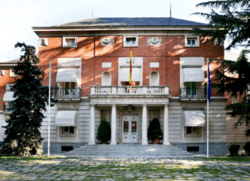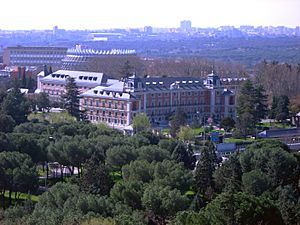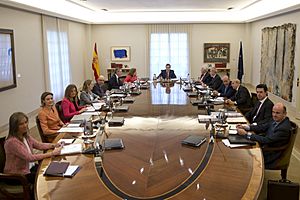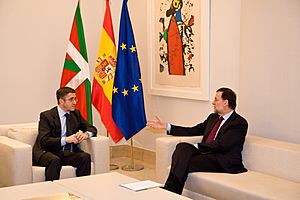Palace of Moncloa facts for kids
Quick facts for kids Moncloa Palace |
|
|---|---|
|
Palacio de la Moncloa
|
|
 |
|

Main facade of La Moncloa Palace
|
|
| Former names | Palace of the Counts of Moncloa |
| Alternative names | La Moncloa |
| General information | |
| Address | Avenida Puerta de Hierro, s/n |
| Town or city | Madrid |
| Country | Spain |
| Coordinates | 40°26′37″N 3°44′14″W / 40.4436°N 3.7371°W |
| Current tenants | Prime Minister Pedro Sánchez and his family. |
| Construction started | 1947 (reconstruction of the 17th century original) |
| Completed | 1955 |
| Renovated | 1977 |
| Owner | Government of Spain |
| Design and construction | |
| Architect | Isidro González Velázquez Joaquín Ezquerra del Bayo Diego Méndez José de Azpiroz y Azpiroz |
The Moncloa Palace (in Spanish: Palacio de la Moncloa) is a very important building in Spain. It is the official home and workplace for the Prime Minister of Spain. Think of it like the White House in the United States, but for Spain's leader!
This palace is located in Madrid, in an area called Moncloa-Aravaca. Since 1977, it has been the main office for the Prime Minister. Before that, the Prime Minister worked from a different palace.
The Moncloa Complex is a large area. It includes 16 different buildings, a special underground shelter (called a bunker), and even a hospital. Many important government offices are here. These include the offices for the Ministry of the Presidency, the Deputy Prime Minister, and the Press Office. The weekly meetings of the Council of Ministers, which is like the main team of government leaders, also happen here.
Sometimes, when people in Spain say 'Moncloa', they are talking about the central government itself. This is especially true when they compare it to the governments of different regions in Spain.
Contents
History of Moncloa Palace
The Moncloa Palace started out as a farm. It was a good spot, so it later became a fancy house. In 1660, a rich person named Gaspar de Haro y Guzmán bought it. He owned the nearby land called La Moncloa. This name came from its old owners, the Counts of Monclova.
When the two pieces of land were joined, Gaspar de Haro built a palace. It was first called Eliche's Palace. It was also known as Painted House because of the cool paintings on its outside walls. Later, it became known as the Palace of La Moncloa.
The Palace had many different owners over the years. Eventually, King Charles IV bought it in 1802. He added it to a royal estate. In 1816, King Ferdinand VII ordered the palace to be fixed up.
About 30 years later, Queen Isabella II gave the palace to the Spanish government. It became part of the Ministry of Development. The palace was fixed up again in 1929 and opened as a museum.
Sadly, the Palace was destroyed during the Spanish Civil War. This happened during the Siege of Madrid.
A decade after it was destroyed, a new building was constructed. This happened between 1949 and 1953. The new building looked like another famous palace, the Casa del Labrador. It was used for important visitors, like leaders from other countries.
In 1954, the Moncloa Palace and its gardens became part of the National Heritage. This means it belongs to the Spanish people. The new palace was opened in 1953. The first foreign leader to visit was Rafael Leonidas Trujillo in 1954.
In 1977, Prime Minister Adolfo Suárez decided to move the government's main office to La Moncloa. The old office was in the Villamejor Palace in central Madrid. The move happened mainly for safety reasons. The new Prime Minister wanted to be in a more secure location. The Moncloa Palace also became the official home for the Prime Minister and their family.
Palace Renovations and Changes
Since 1977, different prime ministers have made changes to the Moncloa Complex. They wanted to make it better for their work and families.
Adolfo Suárez added a tennis court and fixed up the swimming pool. He also covered an old courtyard, turning it into a famous room called the Hall of Columns.
In the early 1980s, Leopoldo Calvo-Sotelo was Prime Minister for a short time. He added more bedrooms on the third floor for his eight children. He also added a music room.
When Felipe González became Prime Minister in 1982, he started a small garden for bonsai trees. His biggest change was building an underground bunker. He got the idea after a failed attempt to overthrow the government in 1981. He also built a new building near the main palace. This new building was for the Council of Ministers meetings. This way, the main palace could be used more as the Prime Minister's private home.
José María Aznar and his family lived at Moncloa from 1996 to 2004. He built a game room for his children. He also added a paddle tennis court, which was his favorite sport.
Sonsoles Espinosa, who is the wife of Prime Minister José Luis Rodríguez Zapatero, made big changes to the private rooms. She liked a simple, modern style. She painted the rooms light colors and changed some of the old furniture. She also hung modern art on the walls.
Mariano Rajoy and his wife did not make many changes. They mainly swapped out some vases.
Visiting and Security
Public Access to Moncloa
For a long time, regular people were not allowed to visit the Moncloa Palace. Only journalists, government workers, and students from schools could enter. Students usually got a short tour of the gardens and the Press Center.
However, since September 2018, Prime Minister Pedro Sánchez has allowed the public to visit the complex. Now, you can see the Press Room, the Council of Ministers' Room, and even some main buildings. These include the Deputy Prime Minister's Office and the Ministry of the Presidency building.
There is also a fun tradition in summer. The Prime Minister gives a special tour of the Palace to the children of the people who work there.
If you want to visit, you need to be a Spanish citizen or live in Spain. You have to ask for a date to visit. When you arrive, you show your ID to the guards. You also have to leave all your electronic devices at the entrance.
Keeping Moncloa Safe
The security of the Moncloa Complex is very important. A special government group called the Department of Security is in charge of this. They protect the Prime Minister, the Deputy Prime Minister, and other government ministers. They also protect their families and the Moncloa Complex itself.
The security agents who work here come from two main police forces in Spain: the Civil Guard and the National Police Corps.
Buildings and Rooms at Moncloa
The Moncloa Complex has many different buildings, each with a special purpose.
Council Building
This building was built in 1989. It was made so that the Prime Minister's home and work areas could be separate.
The Prime Minister's Office works with the Reina Sofía Museum. This means that the art in the building comes from the museum. There are over 140 artworks by famous artists like Joan Miró and Eduardo Chillida. The building also has many beautiful pieces of furniture from the National Heritage.
Council Room
This is the most important room in the Council Building. It is where the Council of Ministers holds its weekly meetings.
Tapestry Room
The Tapestry Room is one of the largest rooms. It is used for official parties and events. Sometimes, press conferences are held here too.
Tàpies Room
The Tàpies Room is where the Prime Minister meets with important guests.
Vice Presidency Building
This is one of the newer buildings in the complex. It was built in 2006. Today, it holds the office of the Deputy Prime Minister.
Seeds Building
The Seeds Building was built in 1950. It was originally part of the Ministry of Agriculture. It got its name because it was where seeds were once stored.
Now, it holds the personal office of the Prime Minister's team. The office of the Chief of Staff is on the first floor. This office has been used by many important people in the past.
INIA Building
The INIA building was built in 1953. It is named INIA because it used to house the National Institute of Agrarian Research. Some people call it the Monastery of the Presidency because it looks a bit like a monastery.
Today, it is the main office for the Ministry of the Presidency.
General Commission Room
Inside the INIA building, meetings of the General Commission are held. This group helps prepare topics for the Council of Ministers to discuss.
Spokesperson Building
This building was also built in 1950. It was another part of the Ministry of Agriculture. It used to be a lab where seeds were studied. When the government moved to Moncloa, it became the Information Office.
Currently, this building holds the Secretariat of State for Press. It has a Press Room where journalists can work. It also has the Press Centre, where the government spokesperson and other ministers talk to the press after Council of Ministers meetings.
Other Buildings
The entire Moncloa Complex has 16 buildings. These buildings house different services that help the Prime Minister's Office. These services include security, official events planning (protocol), and health services.
Prime Minister's Office
The Prime Minister's Office is located inside the Moncloa Palace. It has many people working there. Some are long-term government workers, and others are advisers. The most important person in this office is the Chief of Staff. This person is chosen by the Prime Minister and leads the rest of the office.
The Prime Minister's Office has several important parts:
- Prime Minister's Cabinet: This is the main part of the office. It helps coordinate and manage all the other departments. The Chief of Staff leads it.
- Secretariat of State for Press: This group handles all press-related matters. The Secretary of State for Press is in charge, but they report to the Government's Spokesperson.
- Office of the Deputy Chief of Staff: This office helps with national and political affairs.
- General Secretariat of the Office: This part handles things like official events (protocol) and security.
- General Secretariat for International Affairs, European Union, G20 and Global Security: This group focuses on Spain's relationships with other countries and international organizations.
- Department of Homeland Security: This department focuses on the safety and security within Spain.
See also
 In Spanish: Palacio de la Moncloa para niños
In Spanish: Palacio de la Moncloa para niños







